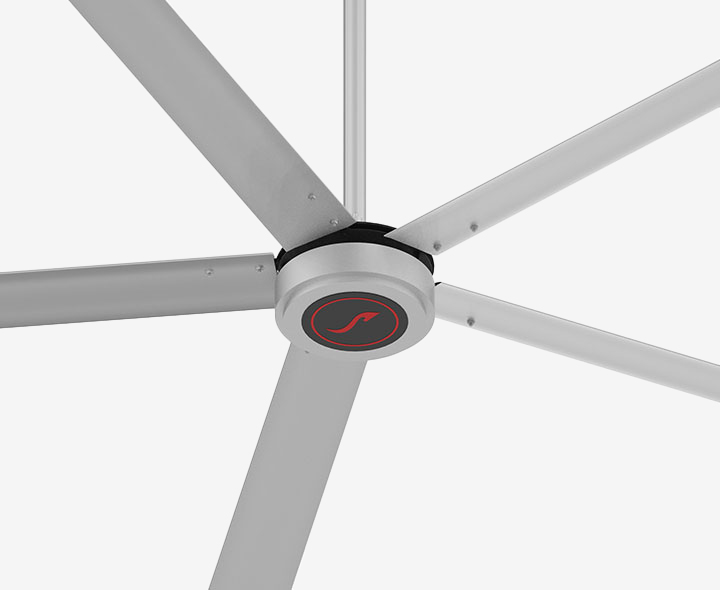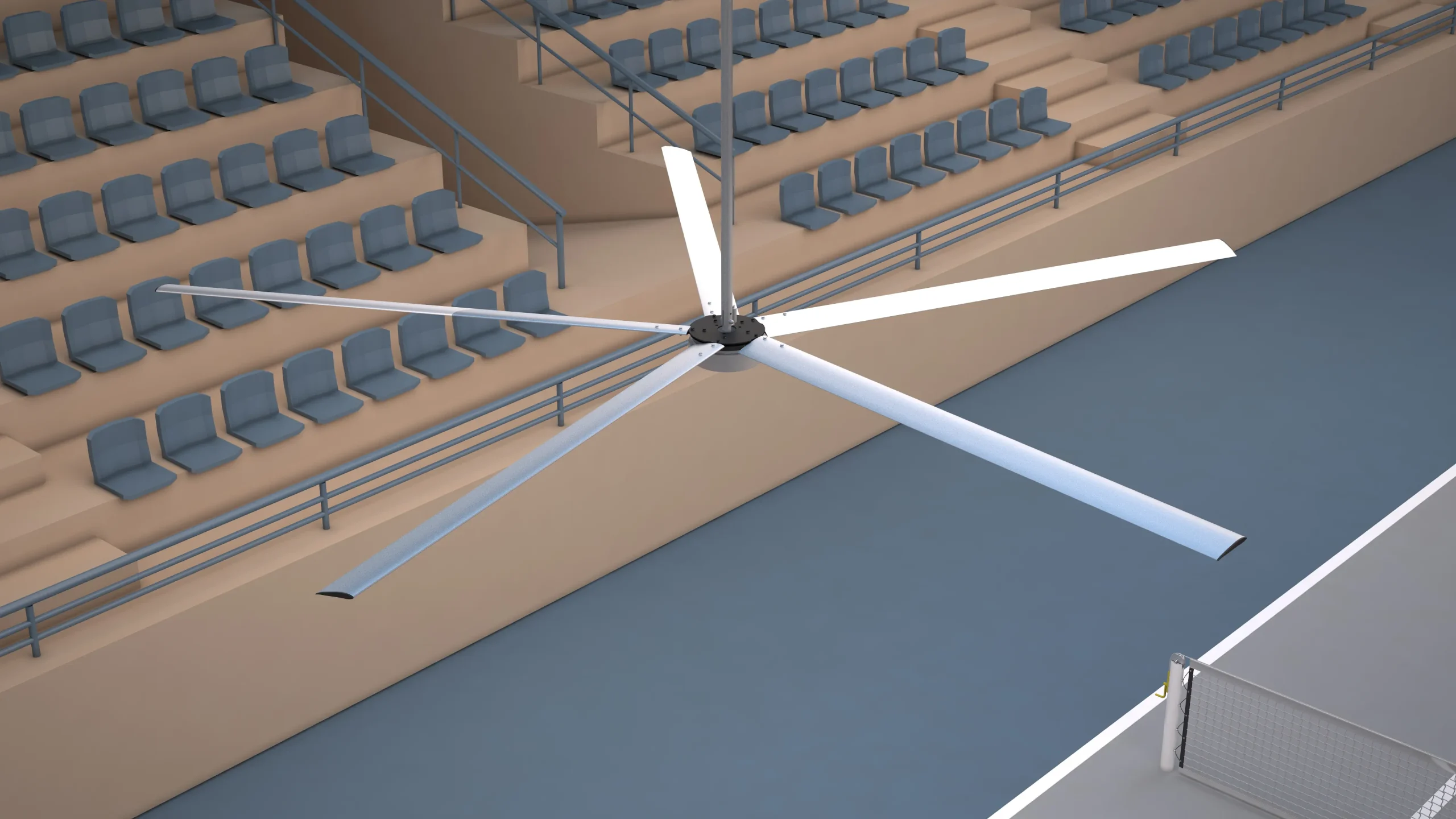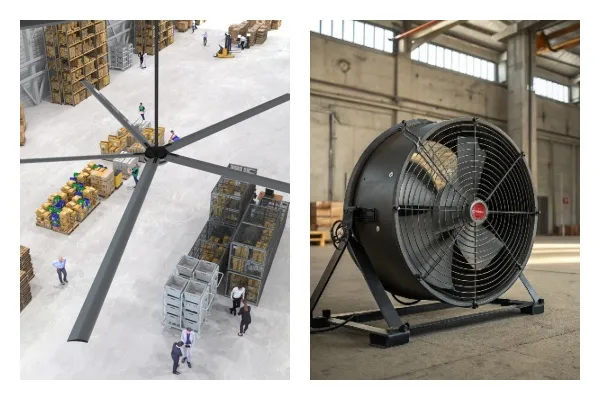Sweat drips, paperwork flutters, and electric meters spin when traditionelle Fans try—and fail—to tame a cavernous plant. Their short blades chop the air without reach. A purpose‑built HVLS-Ventilator, engineered for hohe Lautstärke niedrige Geschwindigkeit performance, spreads smooth comfort while trimming bills.
The best HVLS fan blade material balances light weight, rigidity, and corrosion resistance. Extruded aluminum offers strength and affordability; composite fiberglass resists chemicals; hybrid designs add carbon tips for durability. Paired with long airfoil profiles and shallow Schaufelteilung, these blades move a large volume of air bei niedrige Geschwindigkeit, delivering top‑tier Energieeffizienz in warehouses, gyms, and schools.

hvls fan blade
HVLS steht für hohe Lautstärke niedrige Geschwindigkeit. Unlike a normaler Ventilator—the noisy, high‑RPM device most of us know—an HVLS-Ventilator relies on longer blades (up to 24 feet in diameter) that rotate slowly, creating a coherent column of air that descends, spreads sideways, and returns upward in a gentle cycle. This continuous Luftbewegung fosters even temperature and humidity, improving Luftzirkulation while consuming far weniger Energie.
Science behind HVLS: Wide airfoils produce lift just like airplane wings, letting the fan move large volumes of air efficiently with minimal drag.
Der material used In Lüfterflügel plays a crucial role in safety, durability, and performance. Lightweight, rigid blades minimize bending at the hub and allow these fans to spin steadily without vibration. Corrosion‑resistant alloys keep edges crisp so the Fan-Bewegungen air with each rotation decade after decade.
A good fan blade design is more than an attractive curve—it’s precision engineering and design.
Behind HVLS fan blade design: Computational fluid dynamics tests illustrate how subtle tweaks in chord width or winglets can boost Luftstrom by 12 %.
| Property | Extruded Aluminum | Composite Fiberglass (FRP) | Hybrid Aluminum + Carbon Tips |
|---|---|---|---|
| Gewicht | ★★★☆☆ | ★★★★☆ (light) | ★★★★☆ |
| Korrosion | ★★☆☆☆ | ★★★★☆ | ★★★★☆ |
| Stiffness | ★★★★☆ | ★★★☆☆ | ★★★★★ |
| Kosten | $ | $$ | $$$ |
| Typical Use | Industrieventilatoren in factories | Food/pharma Gewerbeflächen | Harsh chemicals or coastal climates |
Aluminum remains popular because it’s machinable and costs less; however, FRP blades resist acids in agricultural barns. Many Fans bieten a hybrid approach: aluminum roots for strength, carbon‑reinforced tips to prevent sag and keep the Klingengröße consistent over time.

anodized aluminium blades
Modern systems follow UL 507 and ISO 5801 for airflow and structural testing. Hubs use forged steel, and fans are extremely over‑engineered for a 10× safety factor. Retention cables ensure Ventilatoren arbeiten safely if mounting hardware fails. Because Lüfter sind to run near silently, vibration sensors shut units down before imbalance can escalate.
Die Auswahl der richtigen Klingengröße is foundational. While the hub delivers torque, the longer blades — often 18‑24 Fuß im Durchmesser — do the real work, scooping a großes Luftvolumen and throwing it downward without turbulence.
Key engineering note: A 20‑RPM sweep of six airfoils can große Luftmengen bewegen — up to 240 000 CFM — while consuming just 1 kW. That same Luftmenge would require twelve 56‑inch Deckenventilatoren running near 300 RPM.
Measuring simply by Luftstrom is incomplete. Real‑world buyers should weigh:
| Metrisch | Warum es wichtig ist | Typical HVLS Value |
| Luftvolumen (CFM) | Indicates how many cubic feet the Fan-Bewegungen each minute. | 200 000‑240 000 |
| Velocity (fpm) | Comfort depends on “felt” air; 200‑300 fpm is sweet spot. | 220‑260 |
| Energieeffizienz (CFM/W) | Divides CFM by watts to reveal how energieeffizient the unit is. | 200‑300 |
| Energieverbrauch (kWh) | Direct impact on utility bill. | ≈1 kWh |
Denn ein hvls fan is designed für air at a low speed it achieves superb Energieeffizienz. In destratification tests, one unit reduced gas burner runtime 25 %, proving fans will help HVAC systems rest.
Lustige Tatsache: Mit air with each rotation flowing smoothly, occupants feel 4 °C cooler, letting thermostats rise and AC compressors rest — cost less all summer long.
A normaler Ventilator, whether pedestal or residential ceiling model, relies on RPM. Fans are smaller, so to cover distance they must spin fast, creating noise and drafts.
By contrast, Industrieventilatoren umziehen air at low speeds over große Gewerbe- und Industrieflächen. The difference boils down to aerodynamics:
Ceiling fan vs 24‑foot HVLS? The big rotor move large volumes of air efficiently, letting you replace mehrere Lüfter. One unit covers a basketball court; that’s why stadiums and Industrieflächen love them.

Hochgeschwindigkeitslüfter VS Niedriggeschwindigkeitslüfter
Properly placed units support natural Belüftung strategies, pulling fresh air through louvers, then redistributing cooled supply from Klimaanlage registers. Because they cut through the air with minimal drag, they create air with minimal resistance paths that equalize temperature.
Winter Mode: Reverse the speed, and warm ceiling layers return to floor level, saving 20‑30 % on heating fuel.
Summer Mode: Allow these fans to run continuously at 30‑40 RPM; they’ll keep humidity uniform and deter condensation on food lines.
Best practices start with defining Lüfteranwendungen:
Compare Lüftertypen — induction vs PMSM vs hydraulic. Next, run CFD to fans to maximize coverage without dead zones; ensure clearances > 3 ft below trusses so air can move large diagonally. Finally, verify Klingenentwurf pass fail‑safe testing so fans are extremely reliable for decades.
Auch die best fan blade design fails without solid mounting. Use seismic‑rated I‑beam clamps, torque grade‑8 bolts, and double safety cables. Once running, units bei niedrigen Geschwindigkeiten arbeiten making only 39 dBA — fans are quite literally library‑quiet.
Routine care:
Fans bieten instant visual feedback: if you see wobble, shut down and correct — easy because slow RPM lets techs observe safely.
Background: A logistics firm in Phoenix suffered 100 °F pick‑lines. Twelve traditionelle Fans plus Klimaanlage could not keep workers cool.
Solution: Three 24‑foot HVLS units (extruded aluminum blades) installed between racking aisles.
Results:
The manager says, “These blades of HVLS fans feel like a city breeze. One Ventilator bietet what ten blowers could not.”
| Umfeld | Recommended Material | Grund | Anmerkungen |
| Food & Pharma | Composite FRP | Non‑porous, easy sanitation | Meets FDA washdowns |
| Coastal | Hybrid Al + Carbon | Salt spray resistant | 316 SS fasteners |
| General Manufacturing | 6061‑T6 Aluminum | Strong, weniger Energie to spin | Budget‑friendly |
How does blade pitch affect airflow?
A shallow 8‑13° Schaufelteilung maximizes lift so you can move a large volume with fewer amps.
Do HVLS units work in air‑conditioned facilities?
Yes. They destratify cool air, letting thermostats rise 3‑4 °C. That means große Mengen Luft reach occupants while compressors rest.
Can I retrofit to FRP blades later?
Absolutely — hubs accept modular wings; swapping material takes one hour.
Are six blades always better than eight?
Nicht unbedingt. Anzahl der Blätter depends on motor torque. More blades add drag; six is optimal for most diameters.
What warranty do industry‑leading manufacturers give?
Ten years on motor, lifetime on blades — proof engineering and design pay off.

Hallo, ich bin Michael Danielsson, CEO von Vindus Fans, mit über 15 Jahren Erfahrung in der Ingenieur- und Designbranche. Ich bin hier, um mein Wissen weiterzugeben. Wenn Sie Fragen haben, können Sie mich jederzeit kontaktieren. Lassen Sie uns gemeinsam wachsen!